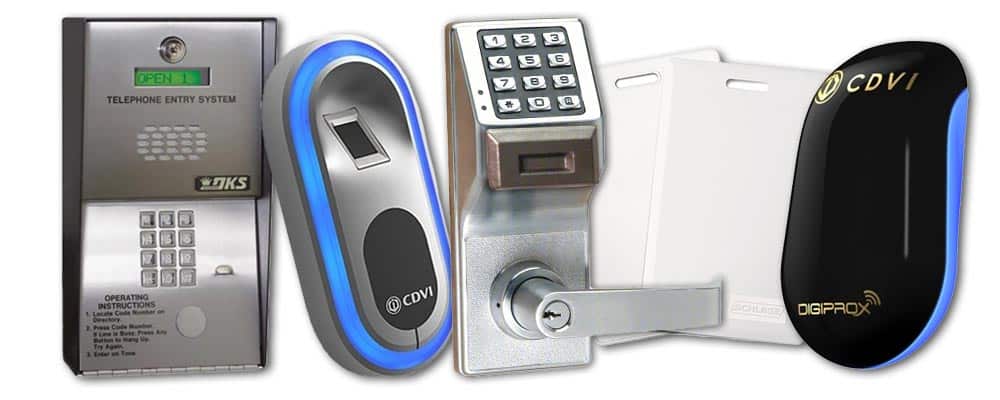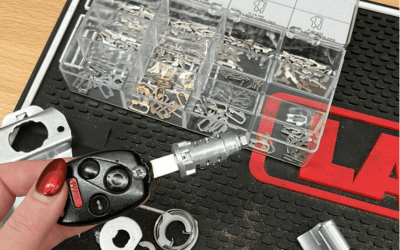Access Control
Want To Save Money? We Offer a 10% Discount for Military, Fire Fighters, Police, and Seniors.
Bob’s Lock Safe & Key is Your Local Access Control Specialist
Control who can enter through your doors and gates. We offer hard-wired and wireless key card access systems and keyless entry devices like PIN code locks. We also sell and install biometric systems that scan fingerprints and faces to authenticate access. Our technicians can diagnose and repair your existing systems, too.
Types of Access Control Devices and Hardware
Every access control system has two components: the hardware and software. While the software controls the system, the physical devices are what your employees, tenants, and other users use to confirm their identity and unlock doors for them. When you hire Bob’s Lock Key & Safe to install an access control system for your property, we will help you choose the best hardware for your unique needs and budget. Here are some of the most common access control devices you can choose from:
- Keypad lock: Users are assigned a unique access code they type in using a digital or push-button keypad.
- Biometric door locks: These locks use biometric information to identify users, including fingerprints, face, voice, iris, and palm or finger vein patterns.
- Key Cards and Fobs: These have a small chip in them with the user’s unique access code, and they use radio-frequency identification (RFID) technology to communicate with the proximity reader.
- Proximity readers: These readers are typically mounted on the wall next to a door, and they communicate with the RFID chip in a user’s key card or fob when it’s held near or waved over the reader.
- Magnetic key card readers: these readers do not use an RFID signal and require users to swipe their key card through the reader.
- Door buzzers/intercoms: These systems allow communication between someone outside a building and those inside before granting access.
- Electronic door locks: Maglocks (magnetic locks) and electronic door strikes are the two main types, and both unlock the door when an authorized user is authenticated via a keycard, fob, PIN, or biometric scanner.

Some of the access control hardware we install for our local clients (L to R): DKS Telephone Entry System, CDVI fingerprint scanner, Alarm Lock keypad lock, Schlage key cards, and a CDVI proximity reader.
Benefits of Access Control Systems
- Enhanced Security: Access control systems provide an extra layer of protection for your business by restricting access to authorized personnel only.
- Customizable: These systems can be customized to fit the specific needs of your business, whether you have a small office or a large warehouse.
- Convenience: With access control systems, you can eliminate the need for physical keys and keep track of who has access to your building without constantly changing locks.
- Cost-effective: Access control systems can save you money in the long run by reducing the risk of theft, vandalism, and other security breaches.
- Remote Access: Some systems allow remote access control, allowing you to manage and monitor your building’s security from anywhere.
- Integration with Other Systems: Access control systems can be integrated with other security systems, such as CCTV cameras and alarms, for a comprehensive security solution.
The 3 Main Types of Access Control Systems
There are three primary access control models used in access security systems, and our expert technicians will help you choose the best type for your property’s security needs:
- Role-Based Access Control (RBAC)—RBAC assigns system access and privileges to users based on their roles or job functions within an organization. For example, the “shipping clerk” role would only get access to shipping/receiving areas, while managers get access to a wider range of restricted spaces. That allows for simplified management of large user groups.
- Attribute-Based Access Control (ABAC) – ABAC grants access rights based on roles and additional attributes about the user, the resource, and the environment. For instance, a user’s department, location, security clearance level, or the resource’s classification or owner can influence permissions. It provides more granular control.
- Discretionary Access Control (DAC) – With this model, resource access is determined by the discretion of the resource owner or administrator. Typically, owners or admins assign permissions to users or groups based on their needs. This model commonly employs access control lists (ACLs), where permissions for specific resources are explicitly defined for individual users or groups. DAC is relatively simple and flexible, allowing resource owners to control access levels for their resources. However, it may also lead to security risks if permissions are not carefully managed.
Why You Should Choose Bob’s Lock Safe & Key in Salt Lake City, Utah
Choosing Bob’s Lock Safe and Key for your access control needs means choosing a trusted and experienced company that has served the Salt Lake City area for over 50 years. Not only are our locksmiths highly trained with years of experience, but they’re also licensed, insured, and bonded, which lets our customers know that their best interests and property protection are assured but also insured.
In addition to access control services, we provide a full range of locksmith and security services for your car, home, business, and safes. We also provide 24-hour lockout service when you lose your keys or lock them inside and need help getting back inside.
Contact us today to learn more about how our access control services can help secure your building and protect your assets. We look forward to serving you!
Call 801-966-6767 to schedule an appointment
Latest Posts From Our Blog
A Guide to Avoiding Locksmith Scammers
Unmasking Locksmith Scams: A Guide to Distinguish Genuine Professionals from Fraudsters When it...
Honda Locks Rekeyed
Bob's Lock, Safe & Key Can Rekey and Repair Honda High-Security Ignition and Door Locks If you...
Installing A New Mag Lock
Installation of a Magnetic Lock on a Commercial Property in Salt Lake City, UT This door is...





